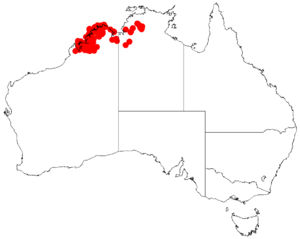Djulurd facts for kids
Quick facts for kids Djulurd |
|
|---|---|
| Scientific classification | |
| Genus: |
Acacia
|
| Species: |
stigmatophylla
|
 |
|
| Occurrence data from AVH | |
Acacia stigmatophylla, also known as djulurd, is a type of shrub found only in the northern parts of Western Australia. It belongs to the Acacia family, which includes many different kinds of wattle plants.
About the Djulurd Plant
The Djulurd plant is a shrub that usually grows to be about 1 to 4 meters (3 to 13 feet) tall. It has smooth, dark grey bark. Its branches are smooth and can be reddish-brown or light brown. They often have sticky, resinous lines.
What Does It Look Like?
The leaves of the Djulurd plant are actually special leaf-like parts called phyllodes. They are straight and green, shaped like a narrow oval or wider at the tip. These phyllodes are usually about 2.5 to 7 centimeters (1 to 2.7 inches) long and 6 to 23 millimeters (0.2 to 0.9 inches) wide. Each one has a small, knob-like tip and three clear lines running along it.
Flowers and Seed Pods
This plant blooms with yellow flowers from January to October. The flowers are shaped like small cups and are spread out. Their petals have a clear line down the middle.
After the flowers, the plant grows brown, woody seed pods. These pods are long and narrow, wider at the tip, and flat. They are about 3 to 7 centimeters (1.2 to 2.7 inches) long and 4.5 to 8.5 millimeters (0.17 to 0.33 inches) wide. When they are ready, the pods spring open from the top. Inside, you'll find dark brown seeds that are about 4 to 6 millimeters (0.15 to 0.23 inches) long.
Where Does It Grow?
The Djulurd plant grows in a large area of the Kimberley region in Western Australia. You can find it from places near Broome all the way east to the border with the Northern Territory.
It can grow in many different places. Sometimes it's found in thin, sandy soils over rocks like granite or sandstone. It's often part of coastal forests that get a lot of rain, especially on hills and ranges. You might also see it growing in grassy plains or open forests with gum trees (Eucalyptus).

